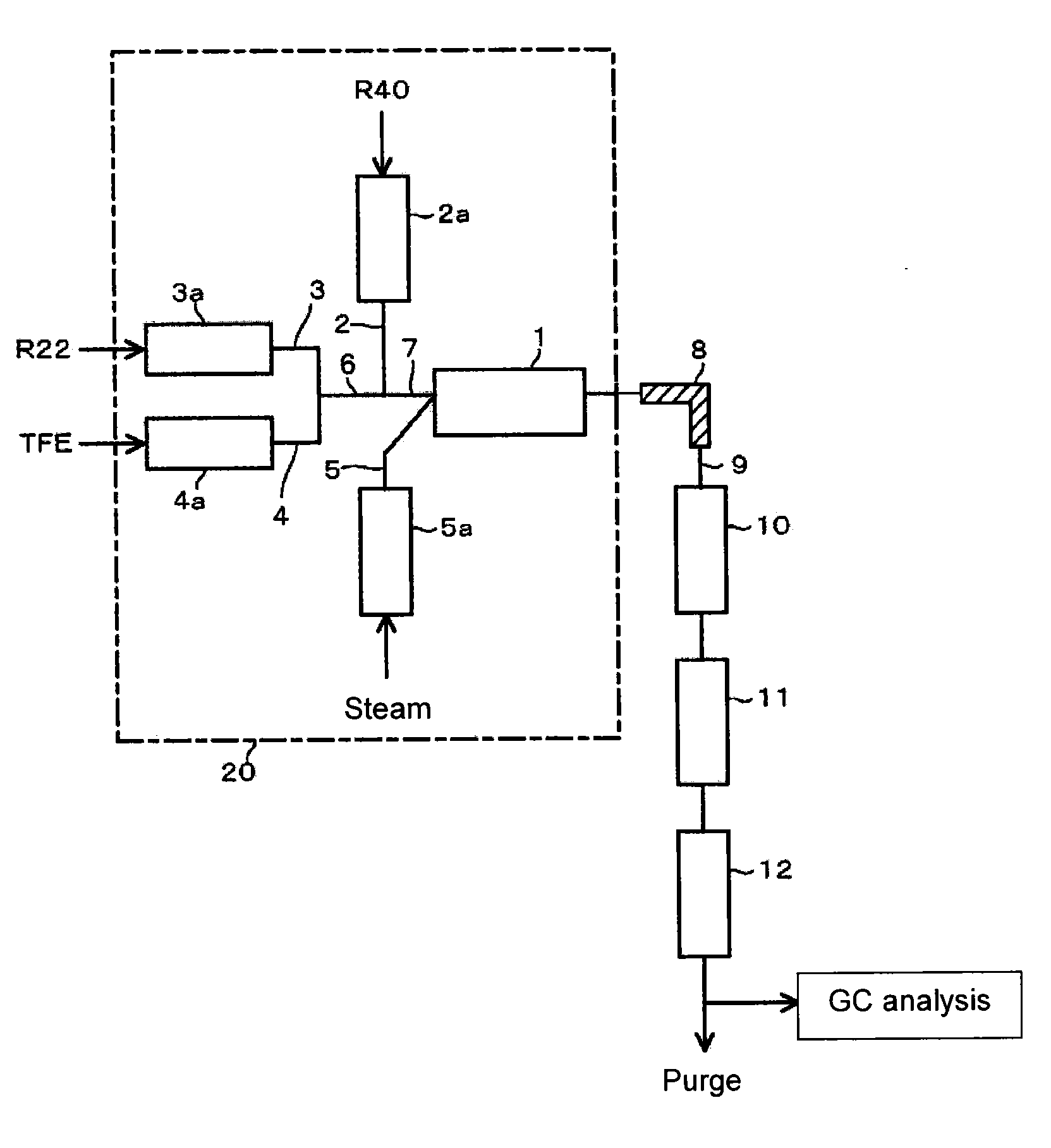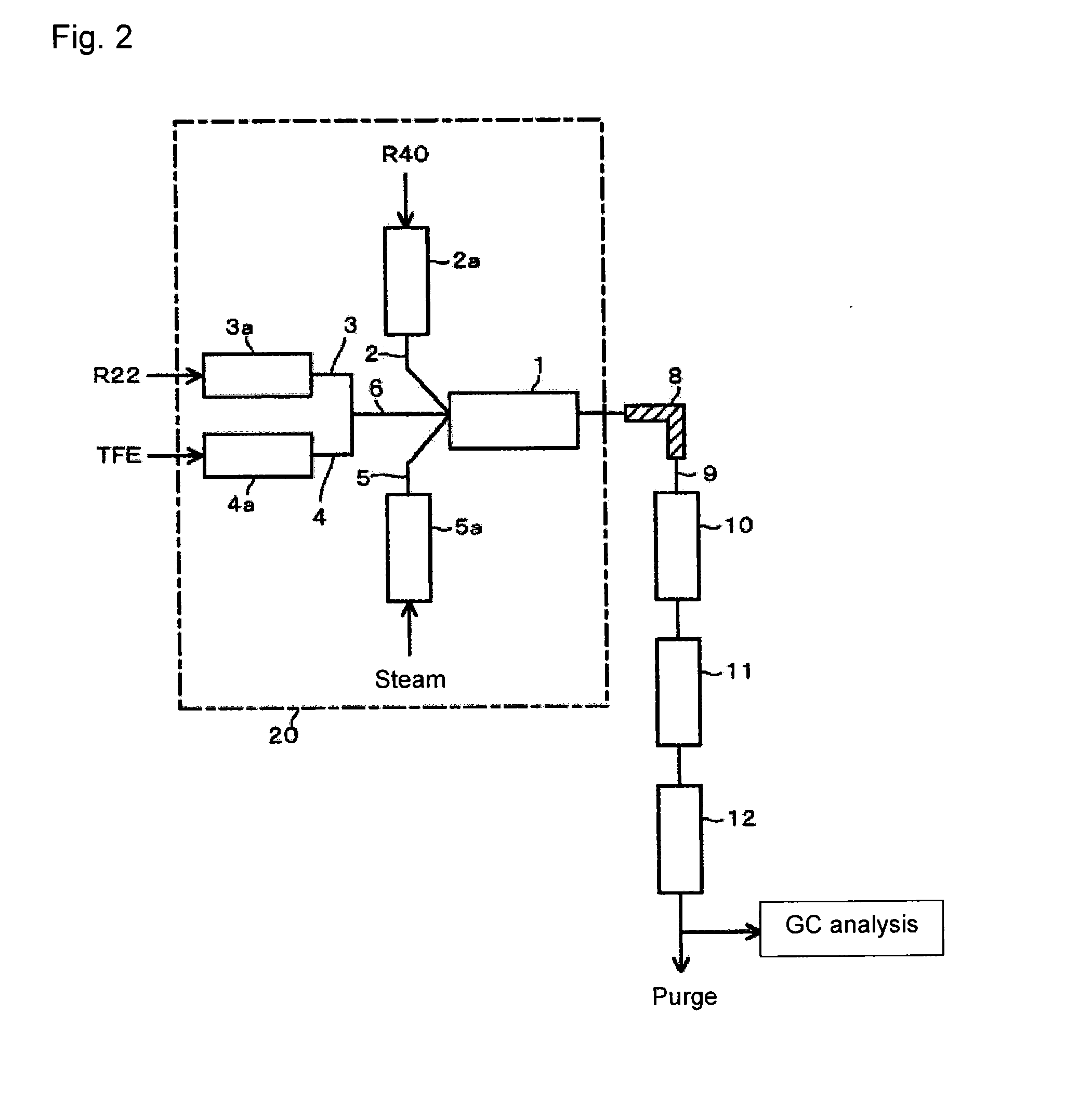Process for producing 2, 3, 3, 3-tetrafluoropropene and 1, 1-difluoroethylene
a technology of tetrafluoropropene and ethylene, which is applied in the field of process for producing 2, 3, 3, and tetrafluoropropene, can solve the problems of high installation cost, difficult distillation/purification of intermediate product and final product, and insufficiently high yield of hfo-1234yf, so as to reduce the cost of raw materials and production facilities, the effect of high yield and substantial economic benefits
- Summary
- Abstract
- Description
- Claims
- Application Information
AI Technical Summary
Benefits of technology
Problems solved by technology
Method used
Image
Examples
example 1
[0064]Using the reaction apparatus as shown in FIG. 1, from a raw material gas comprising R22, R40 and TFE, crude HFO-1234yf and crude VdF were obtained as follows.
[0065]Into a stainless steel tube in an electric furnace set at an internal temperature of 300° C., R40 was continuously introduced, and R40 was heated (preheated) to 300° C. Further, into a stainless steel tube in an electric furnace set at an internal temperature of 300° C., R22 was continuously introduced, and R22 was preheated to 300° C. Furthermore, into a stainless steel tube in an electric furnace set at an internal temperature of 300° C., TFE was continuously introduced, and TFE was preheated to 300° C.
[0066]These preheated raw material gas components (R40, R22 and TFE) and steam (water vapor) heated by an electric furnace set at an internal temperature of 750° C. were supplied to a reactor controlled to have an internal pressure (gauge pressure) of 0.04 MPa and an internal temperature of 800° C., so that the mola...
examples 2 to 4
[0079]The molar ratio (TFE / (TFE+R22)) of the supply amount of TFE to the total supply amount of TFE and R22 was made to be 0.1 (10%) in Example 2, 3 (30%) in Example 3 and 0.7 (70%) in Example 4. Further, so that the equivalent ratio of R40 / (TFE+R22) would be 0.5, the molar ratio of R40 / (TFE+R22) was made to be 0.55 in Example 2, 0.65 in Example 3 and 0.85 in Example 4. Otherwise, the reaction was conducted under the same conditions as in Example 1.
[0080]Then, the gas of the reaction mixture withdrawn from the outlet of the reactor was cooled to at most 100° C. and subjected to recovery of steam and the acidic liquid and alkaline cleaning sequentially and then to dehydration treatment, whereupon the obtained outlet gas was analyzed by gas chromatography, and the molar composition of the gas components contained in the outlet gas was calculated. Further, based on the obtained molar composition of the outlet gas, the conversion (reaction rate) of R40, the selectivity of each component...
example 5
[0085]Without conducting preheating of R40, R22 and TFE, the respective raw material components at room temperature (10° C.) were supplied as they were, to the reactor. Otherwise, the reaction was conducted under the same conditions as in Example 1.
[0086]Then, the gas of the reaction mixture withdrawn from the outlet of the reactor was cooled to at most 100° C. and subjected to recovery of steam and the acidic liquid and alkaline cleaning sequentially and then to dehydration treatment, whereupon the obtained outlet gas was analyzed by gas chromatography, and the molar composition of the gas components contained in the outlet gas was calculated. Based on the obtained molar composition of the outlet gas, the conversion (reaction rate) of R40, the selectivity of each component derived from R40, the conversion (reaction rate) of R22 and / or TFE, the selectivity of each component derived from R22 and / or TFE, and the ratio of HFO-1234yf to CTFE (HFO-1234yf / CTFE) were, respectively, obtaine...
PUM
| Property | Measurement | Unit |
|---|---|---|
| Temperature | aaaaa | aaaaa |
| Temperature | aaaaa | aaaaa |
| Temperature | aaaaa | aaaaa |
Abstract
Description
Claims
Application Information
 Login to View More
Login to View More - R&D
- Intellectual Property
- Life Sciences
- Materials
- Tech Scout
- Unparalleled Data Quality
- Higher Quality Content
- 60% Fewer Hallucinations
Browse by: Latest US Patents, China's latest patents, Technical Efficacy Thesaurus, Application Domain, Technology Topic, Popular Technical Reports.
© 2025 PatSnap. All rights reserved.Legal|Privacy policy|Modern Slavery Act Transparency Statement|Sitemap|About US| Contact US: help@patsnap.com



